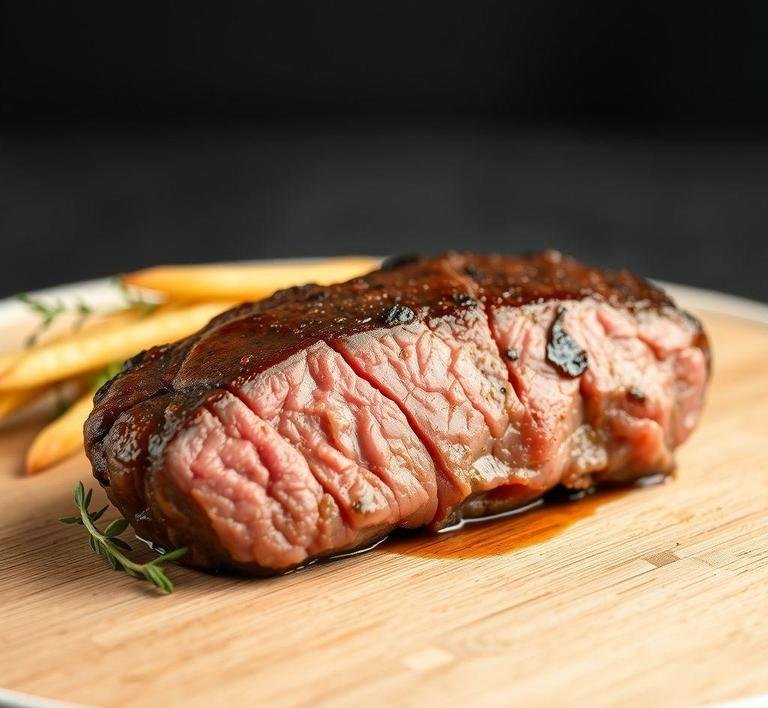Mary Berry’s Beef Fillet is a classic British culinary delight, showcasing the elegance and simplicity of premium beef cooked to perfection. Known for her approachable yet refined cooking style, Mary Berry takes the humble beef fillet – a tender and lean cut prized for its melt-in-the-mouth texture – and elevates it with a careful balance of flavors and techniques that bring out the best in this luxurious meat.
This dish exemplifies Mary Berry’s philosophy: using high-quality ingredients, respecting the natural flavors, and employing straightforward, foolproof cooking methods to create something truly special. The beef fillet itself is often the star of celebratory meals or special occasions, where the focus is on juicy, tender meat complemented by a rich sauce or carefully chosen seasoning that enhances rather than masks its natural character.
In Mary Berry’s rendition, the beef fillet is typically cooked gently, often roasted or pan-seared, then finished in the oven to achieve that perfect rosy center. It’s a dish that can be as simple or as sophisticated as you like – and it lends itself beautifully to pairing with classic British sides like creamy mashed potatoes, roasted vegetables, or a robust red wine jus.
Mary Berry’s Beef Fillet Recipe
Ingredients Needed

To create Mary Berry’s Beef Fillet, the ingredient list is refreshingly short but powerful, emphasizing quality over quantity:
- Beef Fillet (Tenderloin): About 1 to 1.5 pounds (450-700g) of prime beef fillet, trimmed and ready to cook. The fillet is the most tender cut, prized for its fine grain and delicate flavor.
- Olive Oil or Vegetable Oil: For searing, to develop a gorgeous crust and lock in juices.
- Butter: Adds richness during cooking and helps with basting the meat.
- Garlic Cloves: Lightly crushed to infuse gentle aromatic notes.
- Fresh Thyme or Rosemary: These herbs impart subtle earthiness and freshness to the beef.
- Salt and Freshly Ground Black Pepper: Essential for seasoning, enhancing the natural taste of the beef.
- Optional: Red wine or beef stock, if you want to make a simple pan sauce to accompany the fillet.
Mary Berry’s recipes often encourage using minimal seasoning to allow the natural flavor of the beef to shine through, which is why fresh herbs and high-quality salt and pepper are critical here.
Equipment Needed
To execute this recipe with Mary Berry’s signature finesse, a handful of key kitchen tools and equipment will make the process smooth and enjoyable:
- Heavy-based Frying Pan or Cast Iron Skillet: Crucial for achieving that perfect sear. A heavy pan retains heat well and ensures even browning.
- Ovenproof Roasting Tray or Baking Dish: If you plan to finish the beef in the oven after searing, an ovenproof dish is necessary.
- Tongs: To turn the beef fillet carefully without piercing it (to avoid losing precious juices).
- Meat Thermometer: An indispensable tool for checking doneness – you’ll want the beef to reach the perfect internal temperature without guesswork.
- Kitchen Twine: Sometimes used to tie the fillet for even cooking and to maintain its shape.
- Basting Spoon or Ladle: To spoon melted butter and herb juices over the beef during cooking, enriching flavor and moisture.
- Carving Knife: Sharp and sturdy, for slicing the fillet beautifully once rested.
Having these tools ready ensures the cooking process is efficient and the final dish looks and tastes superb.
Instructions To Make Mary Berry’s Beef Fillet
Now, let’s walk through the step-by-step process with detailed explanations:
-
Preparation:
Remove the beef fillet from the fridge at least 30 minutes before cooking to bring it to room temperature. This helps the meat cook evenly.
-
Seasoning:
Generously season the fillet all over with salt and freshly ground black pepper. Pat the seasoning into the meat gently.
-
Preheat your oven:
Set your oven to 200°C (about 400°F), or 180°C for fan ovens.
-
Searing the Fillet:
Heat a heavy-based frying pan over a medium-high flame. Add a splash of oil. When the oil is shimmering but not smoking, place the fillet in the pan. Sear for about 2-3 minutes on each side until a deep golden-brown crust forms. This caramelization locks in flavor and juices.
-
Add Butter and Herbs:
Reduce the heat slightly and add a knob of butter, crushed garlic cloves, and fresh thyme or rosemary to the pan. Using a spoon, baste the fillet with the melted butter and herb-infused oil continuously for a minute or two. This technique adds layers of flavor and keeps the beef moist.
-
Oven Roasting:
Transfer the fillet, along with the butter and herbs, to the ovenproof roasting tray if your pan isn’t oven-safe. Roast in the preheated oven for approximately 10-15 minutes for medium-rare, adjusting the time depending on the size of your fillet and desired doneness.
-
Check Temperature:
Use a meat thermometer to check the internal temperature: about 54°C (130°F) for medium-rare, 60°C (140°F) for medium.
-
Resting:
Remove the fillet from the oven and cover loosely with foil. Rest for at least 10 minutes. Resting allows the juices to redistribute throughout the meat, resulting in a tender, juicy fillet.
-
Serving:
Slice the beef fillet into thick medallions. Optionally, drizzle with the pan juices or a simple red wine reduction sauce. Serve immediately with your favorite sides.
Tips And Tricks
- Room Temperature is Key: Never cook beef straight from the fridge; letting it sit at room temperature ensures even cooking.
- Searing is Crucial: Don’t rush the searing step; a deep crust locks in moisture and flavor.
- Use a Meat Thermometer: This is the best way to guarantee perfect doneness without cutting into the meat prematurely.
- Don’t Skip Resting: Resting is vital – skipping this can cause all the precious juices to run out when slicing.
- Herb and Butter Basting: This classic technique adds richness and subtle aromatic flavor that elevates the dish.
- Tie Your Fillet: If your beef fillet is uneven in thickness, consider tying it with kitchen twine to help it cook uniformly.
- Pair Wisely: Mary Berry often suggests pairing the fillet with classic sides like roasted potatoes, seasonal vegetables, or a creamy horseradish sauce to complement the beef.
Mary Berry’s Beef Fillet is a shining example of how simple, high-quality ingredients paired with thoughtful cooking techniques can transform a meal into a memorable culinary experience. This dish is the perfect marriage of tenderness, flavor, and elegance – embodying Mary Berry’s timeless approach to cooking that’s accessible to home cooks yet impressive enough for special occasions.
Whether you’re an aspiring cook looking to master a classic or someone wanting to impress guests with a beautiful centerpiece, Mary Berry’s Beef Fillet offers a rewarding and delicious journey. With the right ingredients, tools, and a little bit of patience, you can create a dish that honors tradition while delighting your taste buds. It’s not just cooking; it’s an experience – one you’ll want to revisit again and again.
Easy Recipe Variations For Mary Berry’s Beef Fillet

Mary Berry’s Beef Fillet is a classic, elegant dish known for its tender, juicy center and beautifully caramelized exterior. While the original recipe showcases the pure flavor of the beef with subtle seasoning, there’s plenty of room to experiment and tailor this dish to different tastes and occasions. Here are some delicious variations that remain easy yet add exciting new layers to this timeless recipe:
-
Herb-Crusted Beef Fillet:
Elevate the fillet by coating it with a fresh herb crust. A mixture of finely chopped rosemary, thyme, garlic, and parsley combined with a touch of olive oil creates a fragrant, flavorful crust that complements the natural beefiness. Simply press the herb blend onto the meat before searing and roasting. The result is an aromatic dish with a slightly crunchy herbaceous exterior.
-
Peppered Fillet with Mustard Glaze:
For those who like a bit of a kick, press cracked black peppercorns onto the beef fillet before cooking. After searing, brush the fillet lightly with Dijon mustard, which will caramelize in the oven and add a tangy sweetness balanced with spice. This variation gives a lovely punch to the flavor without overpowering the tender beef.
-
Stuffed Beef Fillet:
Take a little more time and impress guests with a stuffed version. Butterfly the fillet and fill it with a mixture of sautéed mushrooms, garlic, spinach, and a little crumbled blue cheese or goat cheese. Roll it up and tie it with kitchen string before searing and roasting. This variation introduces richness and an extra depth of flavor, making it perfect for special occasions.
-
Asian-Inspired Fillet:
For a twist, marinate the beef in a blend of soy sauce, ginger, garlic, and a touch of honey for about 30 minutes before cooking. Finish the fillet with a quick glaze of hoisin sauce or teriyaki reduction after roasting. This fusion variation pairs beautifully with simple steamed rice and stir-fried vegetables.
-
Fillet with Red Wine and Shallot Sauce:
After cooking the fillet, use the pan drippings to make a luxurious red wine reduction with shallots and a touch of butter. This sauce can be spooned over the fillet or served on the side. It adds a refined, rich component that enhances every bite without complicating the original recipe.
These variations not only highlight the versatility of Mary Berry’s Beef Fillet but also allow home cooks to adapt the dish to suit their personal taste or the season. Whether you prefer herbs, heat, stuffing, or international flair, there’s a variation here to inspire your culinary creativity.
Storing Leftovers
One of the joys of cooking a beef fillet is having delicious leftovers that can be enjoyed in a variety of ways. However, proper storage is key to preserving the flavor, texture, and safety of the meat. Here’s an in-depth guide to storing your leftover Mary Berry’s Beef Fillet:
-
Cooling Down:
After cooking, allow the fillet to cool to room temperature but do not leave it out for more than two hours to prevent bacterial growth. It’s best to slice the fillet first if you plan to eat it cold or reheat in portions.
-
Wrapping and Containers:
Wrap the leftover beef tightly in cling film or aluminum foil to prevent air exposure, which can dry out the meat. Alternatively, place slices in an airtight container. For best results, separate the slices with parchment paper to avoid sticking.
-
Refrigeration:
Store the wrapped or containerized beef in the coldest part of your fridge. Leftover beef fillet will stay fresh for up to 3-4 days. Make sure your fridge temperature is set below 5°C (41°F) to keep it safe.
-
Freezing:
If you want to keep the fillet longer, freezing is an excellent option. Wrap the beef fillet tightly in cling film and then in foil to protect it from freezer burn. Place it in a freezer-safe bag or container. Label with the date and consume within 2-3 months for optimal taste. When ready to use, thaw overnight in the fridge.
-
Reheating Tips:
To reheat without drying out the beef, avoid microwaving directly on high heat. Instead, gently warm slices in a pan over low heat with a splash of broth or water to maintain moisture. Alternatively, wrap slices in foil and warm in a low oven (about 150°C/300°F) until heated through. Avoid overcooking to keep the fillet tender.
Proper storage ensures that you can enjoy the wonderful flavors and texture of Mary Berry’s Beef Fillet long after the initial meal, making it perfect for busy days or quick, elegant lunches.
What To Eat With Mary Berry’s Beef Fillet?
Mary Berry’s Beef Fillet, with its rich, succulent taste, pairs beautifully with a variety of sides that can complement and balance the dish. Whether you’re aiming for classic British comfort or something with a contemporary twist, here are some perfect accompaniments:
-
Classic Roast Potatoes or Dauphinoise:
Crispy roast potatoes with a fluffy interior are a natural partner to beef fillet. Alternatively, a creamy dauphinoise potato, layered with garlic, cream, and cheese, adds luxurious texture and richness that pairs wonderfully with the beef’s depth.
-
Seasonal Roasted Vegetables:
Roasting vegetables such as carrots, parsnips, Brussels sprouts, and beets caramelizes their natural sugars, adding sweetness and earthiness that complement the savory beef. A drizzle of honey or balsamic glaze over the veggies can bring out even more flavor.
-
Green Vegetables with a Twist:
Tender greens like sautéed spinach, steamed asparagus, or green beans tossed with toasted almonds or lemon zest provide freshness and a slight crunch, balancing the heaviness of the meat.
-
Mushroom or Red Wine Sauce:
A mushroom sauce with garlic and cream or a rich red wine jus enhances the beef’s flavor. These sauces add moisture and complexity, creating a restaurant-quality experience.
-
Fresh Side Salad:
For a lighter, fresher accompaniment, try a mixed leaf salad with peppery arugula, cherry tomatoes, and a tangy vinaigrette. This cuts through the richness of the beef and adds a vibrant contrast.
-
Yorkshire Pudding:
For a truly British feast, serve the fillet alongside golden Yorkshire puddings. Their light, airy texture and slight crispiness make a delightful contrast with tender beef.
-
Polenta or Creamy Mash:
Creamy mashed potatoes with butter and cream are always a comforting choice, but for a slightly different texture, try soft polenta. It’s smooth, slightly sweet, and absorbs sauces beautifully.
Choosing sides that offer a combination of textures and flavors will elevate your Mary Berry Beef Fillet dinner to something memorable and satisfying every time.
Conclusion
Mary Berry’s Beef Fillet is more than just a recipe – it’s an invitation to celebrate the beauty of simple, quality ingredients elevated by expert technique and a touch of personal creativity. Its tender, juicy core and golden, flavorful crust make it a showstopper for any meal, whether a casual family dinner or a special occasion.
With easy variations, from herb-crusted to stuffed or marinated styles, the dish can adapt to a wide range of tastes, reflecting your mood and the season. Storing leftovers thoughtfully ensures that the magic of this dish lingers beyond the first serving, while pairing it with classic and inspired sides transforms the meal into a well-rounded culinary experience.
Ultimately, Mary Berry’s Beef Fillet embodies comfort, elegance, and the joy of cooking – a timeless recipe that invites you to savor every bite and share great food with those you love. So whether you follow the original recipe or put your own spin on it, this dish promises delicious memories and a warm place at the dinner table.
FAQs
What Are The Key Ingredients In Mary Berry’s Beef Fillet Recipe?
Mary Berry’s beef fillet recipe requires a few key ingredients to bring out the rich flavors of the beef. The main ingredient is a high-quality beef fillet, which is usually around 1-1.5 kg in weight. Other essential ingredients include olive oil, butter, garlic, fresh thyme, and a good red wine for deglazing the pan. Additionally, seasoning with salt and pepper is important for enhancing the flavors.
How Do I Achieve A Perfect Sear On The Beef Fillet In Mary Berry’s Recipe?
To achieve a perfect sear on the beef fillet in Mary Berry’s recipe, it’s crucial to ensure the pan is very hot before adding the beef. Start by preheating the pan with a tablespoon of oil. Once the oil is shimmering, season the beef fillet generously with salt and pepper, then place it in the pan. Avoid moving the fillet once it’s in the pan to allow for an even sear. Sear the beef for about 2-3 minutes on each side until a golden-brown crust forms, which will lock in the juices and flavor.
Can I Make Mary Berry’s Beef Fillet Recipe Ahead Of Time?
Mary Berry’s beef fillet recipe is best enjoyed fresh, as beef fillet tends to lose its tenderness if reheated. However, if you need to prepare some elements ahead of time, you can sear the beef fillet earlier in the day, then refrigerate it. To finish, simply allow the beef to come to room temperature before roasting it in the oven to your preferred doneness. The sauce, made from wine, butter, and herbs, can also be made ahead and reheated just before serving.


